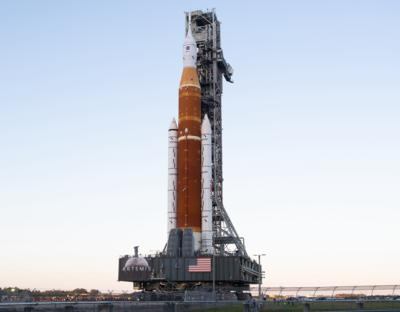Tue, Sep 27, 2022
Tropical Storm Ian Precludes 27 September Liftoff
The launch of Artemis I—the inaugural mission of NASA’s five-flight Artemis lunar program—has been postponed for a third time. The most recent postponement is attributed to concerns over Tropical Storm Ian, which is making its way northwest at a rate likely to see it near enough Florida’s Cape Canaveral area to pose unacceptable risk to United Launch Alliance’s SLS Rocket on its planned, 27 September launch date.

After meeting on Saturday, 24 September, and electing to scrub the launch, NASA flight directors instructed ground personnel to prepare the SLS rocket-stack to be removed from launch-pad 39-B and rolled back into the Kennedy Space Center’s Vehicle Assembly Building (VAB)—the 129,428,000-cubic-foot structure in which NASA engineers and technicians integrate boosters and spacecraft into cohesive vehicles and stack them onto mobile launch platforms in preparation for crawler transport to one of the Cape’s three launch-pads.
By dint of atmospheric data provided by the U.S. Space Force, the National Hurricane Center, and the National Oceanic and Atmospheric Administration, Artemis Program officials will presently render their final decision to either return the SLS rocket to the Vehicle Assembly Building or leave it to ride out the storm on the launch-pad. Should NASA brass so choose, the process of rolling the rocket back inside the VAB would commence late Sunday (25 September), or early Monday (26 September). Once underway, the crawler by which the SLS is transported can take up to ten-hours to make the 4.2-mile (6.8-kilometer) trip from launch-pad 39-B back to the VAB.
Left upon the launch-pad, the SLS rocket stack is capable of withstanding winds up to 85-miles-per-hour (74.1-knots). However, once saddled-up on a crawler and enroute the VAB, the SLS cannot survive winds higher than 46-miles-per-hour (40-knots).

Despite NASA officials having identified an early October launch window for the star-crossed Artemis I mission, it remains unlikely that a new launch date will be formalized until the pending rollback decision has been made. In a press release, NASA stated: “The agency is taking a step-wise approach to its decision making process to allow the agency to protect its employees by completing a safe roll in time for them to address the needs of their families while also protecting for the option to press ahead with another launch opportunity in the current window if weather predictions improve.”
Among the more interesting limitations by which the Artemis I launch is constrained is a prohibition against flying through precipitation. Subject limitation is designed to circumvent the SLS encountering natural lightning, or engendering rocket-triggered lightning strikes—both of which can cause damage to the SLS and endanger public safety. Rocket-triggered lightning forms when a large launch vehicle flies through an atmospheric electric field of sufficient strength to generate a static discharge.
More News
Hold Procedure A predetermined maneuver which keeps aircraft within a specified airspace while awaiting further clearance from air traffic control. Also used during ground operatio>[...]
Altitude Readout An aircraft’s altitude, transmitted via the Mode C transponder feature, that is visually displayed in 100-foot increments on a radar scope having readout cap>[...]
Aero Linx: European Hang Gliding and Paragliding Union (EHPU) The general aim of the EHPU is to promote and protect hang gliding and paragliding in Europe. In order to achieve this>[...]
Also: Skydio Chief, Uncle Sam Sues, Dash 7 magniX, OR UAS Accelerator US Secretary of the Air Force Frank Kendall was given a turn around the patch in the 'X-62A Variable In-flight>[...]
"The need for innovation at speed and scale is greater than ever. The X-62A VISTA is a crucial platform in our efforts to develop, test and integrate AI, as well as to establish AI>[...]
 ANN's Daily Aero-Term (05.09.24): Hold Procedure
ANN's Daily Aero-Term (05.09.24): Hold Procedure ANN's Daily Aero-Term (05.06.24): Altitude Readout
ANN's Daily Aero-Term (05.06.24): Altitude Readout ANN's Daily Aero-Linx (05.06.24)
ANN's Daily Aero-Linx (05.06.24) Airborne-NextGen 05.07.24: AI-Piloted F-16, AgEagle, 1st 2 WorldView Sats
Airborne-NextGen 05.07.24: AI-Piloted F-16, AgEagle, 1st 2 WorldView Sats Aero-News: Quote of the Day (05.07.24)
Aero-News: Quote of the Day (05.07.24)




